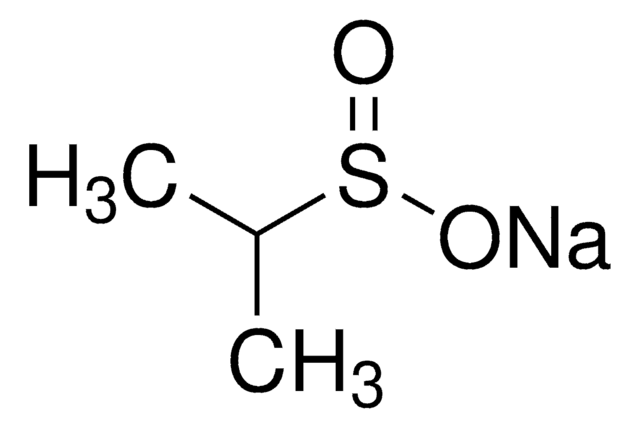745480
Zinc isopropylsulfinate
95%
Synonym(s):
Baran Isopropylation Reagent, Baran IPS Reagent, Bis((isopropylsulfinyl)oxy)zinc, IPS
About This Item
Recommended Products
Quality Level
Assay
95%
form
solid
reaction suitability
reaction type: Allylation
reaction type: C-C Bond Formation
reagent type: catalyst
reaction type: C-H Activation
reagent type: diversification reagent
mp
161-166 °C
functional group
sulfinic acid
SMILES string
CC(C)S(=O)O[Zn]OS(=O)C(C)C
InChI
1S/2C3H8O2S.Zn/c2*1-3(2)6(4)5;/h2*3H,1-2H3,(H,4,5);/q;;+2/p-2
InChI key
PEEMMWYYSHSBTQ-UHFFFAOYSA-L
Looking for similar products? Visit Product Comparison Guide
Application
Practical and Innate Carbon-Hydrogen Functionalization of Heterocycles
Learn More at the Professor and Product Portal of Professor Phil S. Baran.
Linkage
Preparation Note
Other Notes
Signal Word
Danger
Hazard Statements
Precautionary Statements
Hazard Classifications
Aquatic Acute 1 - Aquatic Chronic 1 - Eye Dam. 1 - Skin Corr. 1B - STOT SE 3
Target Organs
Respiratory system
Storage Class Code
8A - Combustible corrosive hazardous materials
WGK
WGK 3
Flash Point(F)
Not applicable
Flash Point(C)
Not applicable
Choose from one of the most recent versions:
Already Own This Product?
Find documentation for the products that you have recently purchased in the Document Library.
Related Content
The synthesis of heteroaromatic and aromatic compounds is at the heart of the chemical industry. The ever-growing demand for new chemical entities, coupled with dwindling resources and time constraints allotted to any given research project, a rapid way to diversify (hetero)aromatic scaffolds is needed.
Our team of scientists has experience in all areas of research including Life Science, Material Science, Chemical Synthesis, Chromatography, Analytical and many others.
Contact Technical Service










